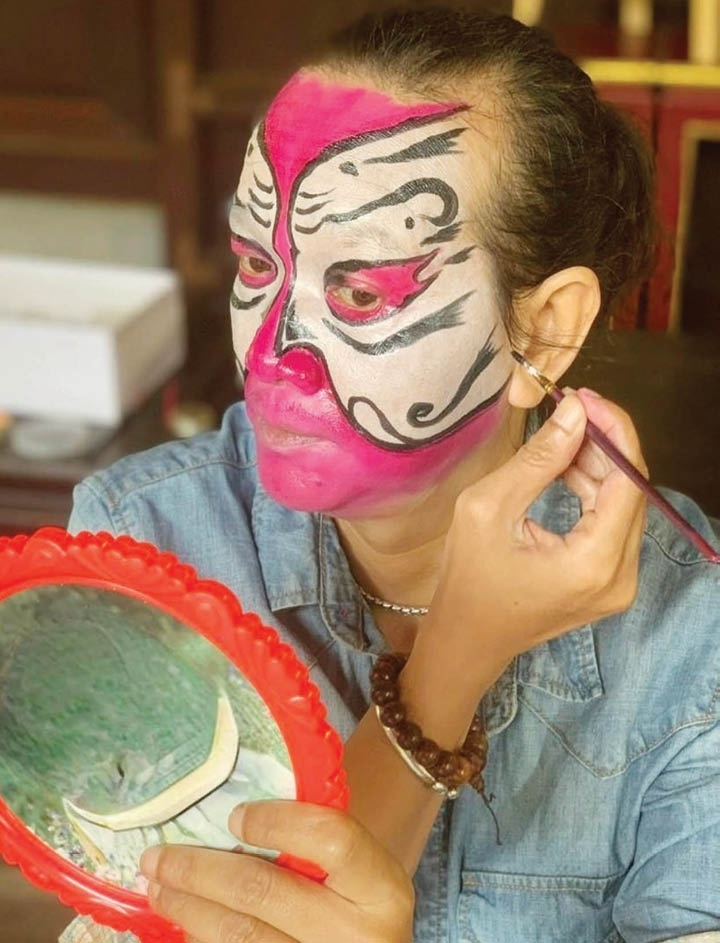The exhibition space introduces over 300 mask products by students. These are the fruits of the program for training and instructing the technique of painting tuồng masks, set up by the Hue Monuments Conservation Center and sponsored by the Vingroup Innovation Fund (VinIF).
Tuồng art brought to the public
Hue royal tuồng is a comprehensive art form, including poetry, singing, music, painting, and acting. From the royal court, Hue royal tuồng has spread and more or less influenced the national stage.
After the ups and downs of history, Hue Royal tuồng has been restored and promoted, but many obstacles lie ahead. To contribute to preserving the values of intangible cultural heritage, especially Hue tuồng art, VinIF has sponsored the training and teaching for artists and actors to grasp and inherit the technical sequence and method of drawing Hue tuồng masks.
Recently, the project "Restoring, instructing and building the space to exhibit Hue tuồng mask art - a traditional art form at high risk of being lost" has been one of eight cultural-historical projects selected for sponsorship by VinIF.

Meritorious Artist La Hung drew himself the mask of the character he played
Ms. Nguyen Mai Phuong, Head of the Applied Research Department under Hue Royal Traditional Arts Theater, Project Manager said that in tuồng art, the mask-drawing art is one of the exceptional and typical factors. The mask is the vital stage prop. The uniqueness of the mask language is also one of the core factors that create the value of Hue tuồng art. So far drawing masks in tuồng art has been orally handed down and imitated. Over time, because most people have not yet comprehended the unique sense in each detail of the pattern, tuồng mask-drawing artists have gradually lost their traditionalism and identity.
The project was set up to train and instruct the artists and actors of the theater in the technical sequence and method of drawing Hue opera masks. The instruction course enables students to improve their experience and skills and supplement knowledge about the specific sense of each design, pattern, and mask to manifest the true nature and mien of the character.
“After the students' products were completed, we arranged them in an exhibition space right in the Duyet Thi Duong Theater, where tuồng used to be performed for kings, royal family members, high-ranking mandarins, and envoys to enjoy. This is both a tourist attraction and a space to introduce and promote tuồng art, bringing tuồng closer to the public, thereby spreading Vietnamese culture in general and Hue tuồng art in particular," Ms. Phuong said.
Skills handed down
Hue Royal Traditional Arts Theater is a key unit in performing traditional art forms, including royal tuồng, but at the theater, at present, only a few artists can paint tuồng masks. All of them get old while the number of successors is too small. If not soon trained and handed down, sooner or later painting tuồng masks will be in danger of being lost.
Meritorious Artist Hoang Trong Cuong, Deputy Director in charge of the Theater said that the training course was directly taught by Meritorious Artist La Hung, son of the late famous royal tuồng artist La Chau. After three months of implementation, the project created 300 products, which are student-made masks of characters in typical tuồng.
15 artists and actors joined in the training course, the youngest of whom is only in his twenties. The project instructed 20 typical character mask models with the most typical criteria for the roles such as kings, generals, actors, actresses with masks of loyalty and flattery; male and female masks, right and evil masks …
The students were provided with basic information about character model theory and then were instructed to draw on papier-mâché masks and their own faces. Finalizing the course, the artists and actors master the drawing steps and can draw for both their co-actors and the very character they play.
The students painted the masks of some characters in typical tuồng such as King Tru in the play Tram Huong Cac, Ky Lan Anh in the play Ho Sanh Dan, Duong Pham in the play Dang Chinh Tay, Phan Dien in the play Son Hau; Cao Hoai Duc in the play Luu Kim Dinh, Ta Ngoc Lan in the play Hong Son Flame, Dao Tam Xuan in Dao Tam Xuan causing the royal court chaos, Ly Ngu Tinh in Ly Phung Dinh...
According to Meritorious Artist Hoang Trong Cuong, the project has contributed to preserving the art of tuồng in general and the unique type of tuồng mask in particular. "Through the project, the Theater has the successors, providing a basis for us to keep maintaining the course every year to instruct novice artists and actors," Mr. Cuong said.